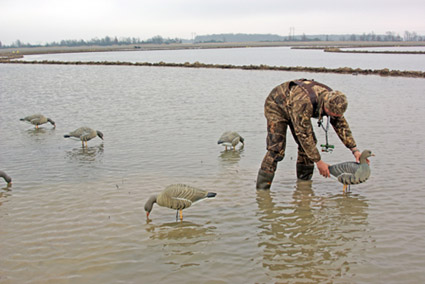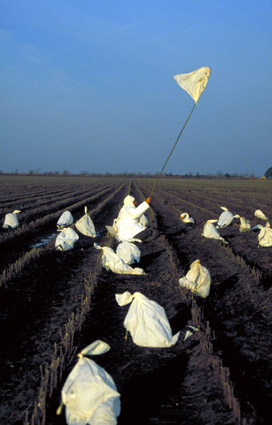 Goose decoys are best placed in central portions of fields, away from cover. |
Find The Best Concealment
When selecting a goose-hunting location in a harvested crop field, look for areas that have elevated stubble or more prevalent stubble. Hiding is the most important factor in waterfowl hunting. If you can locate areas that will better conceal the hunters, your chances for killing geese greatly improve.
Put Decoys In The Proper Place
Place your most realistic decoys (full bodies, shells and floaters) on the downwind side of your decoy spread near the “landing zone” where geese will see them as they approach. Place the least realistic decoys (silhouettes, windsocks and rags) farthest from the view of approaching birds.
Dekes In The Middle
It’s best not to set goose decoys near fence lines, brush piles, high vegetation or ditches that offer natural cover; geese shy away from any cover that can conceal predators. Place your decoys in the middle of the field or water where geese can see all around them.
Watch The Weather
Hunters also should pay attention to weather conditions and bird activity when setting up a decoy spread. When it is warm or calm, geese tend to spread out more across fields and water, and often will break into smaller family groups. As the weather gets colder or when the wind picks up, geese tend to huddle into more tightly packed flocks. Set your spread accordingly.
Adapt To Conditions
Also remember, when the weather gets cold and snowy, geese naturally tend to lay down in the field. Utilizing more shell decoys helps you better replicate these cold-weather flocks. If full-bodied decoys are used, simply remove the bases or legs so the decoys lay flat on the ground.
Add Some Crows
Savvy goose hunters often place a few crow decoys off to one side of their field spreads. These “confidence” decoys help lessen the wariness of geese by making the spread appear more lifelike.
Use Jerk Cords
When hunting waters on calm days, rigging several jerk cords is an inexpensive way to add movement to your spread that will help fool the wariest birds. Tie three to five floating decoys 5 to 7 feet apart along a cord. Anchor one end and use the other end to “pull” the decoys into motion.
 A white trash bag makes a great snow goose flag. |
Mud Your Blind
Looking natural is always crucial. The best way to fully conceal your layout blind or pit is to “mud” the material before any natural vegetation is applied. Simply mix up a bucket of dirt and water and rub the slurry across the blind material. Be sure to let it dry before going afield. The mud will eliminate all unnatural shine or sharpness.
Elongate Decoy Stakes For Even Better Concealment
Hunters also can use any type of decoy — full-body, shell or other styles — to help conceal layout blinds where natural cover is scarce and shadows are prevalent. Raise the decoys slightly by lengthening the stakes 6 to 8 inches, then place them around the perimeter of your blind.
Trash Bag Flag
Realistic flags and kites are great for drawing the attention of snow geese to your decoy spread, but a 13-gallon white trash bag tied to a long pole works just as well.
Keep Calling
Don’t stop calling when geese are close. Feeding and landing geese make a lot of noise; a silent goose flock is either asleep or alarmed.
Look For The “X”
Geese will always have a specific area where they tend to land. Each day you hunt, be sure to remember the exact spot in the field where the birds pitched in. The next day you will be much more successful if you are set up on the “X.”
Note: Keith Sutton is the author of numerous books on hunting, fishing and the outdoors. Autographed copies are available through his website, www.catfishsutton.com.






